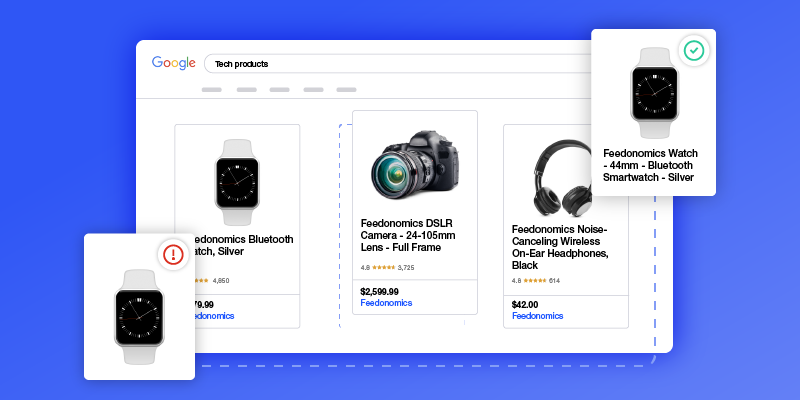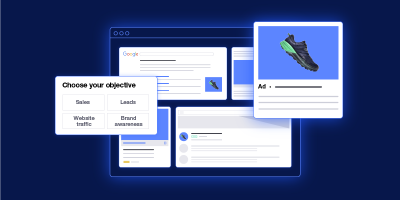It’s no secret that Google Shopping is a powerful way to reach potential customers. With its estimated 5.6 billion searches a day, Google captures a little more than 92% of the search engine market. That means Google Shopping has the potential to showcase your product listings to millions of potential buyers, but success requires more than simply uploading a product feed and waiting for great results.
Recently, Feedonomics’ Ben Thomson, Director of Business Development for the Europe, Middle East, and Africa (EMEA) region, was a guest on the eCom@One podcast episode, “How You Can Optimise Your Product Feeds to Boost Profitability,” hosted by Richard Hill. Ben and Richard discussed why merchants should take advantage of Google Shopping, what to include in listings to increase profitability, and the common mistakes our feed managers see merchants making on Google Shopping. Here are three of the most common Google Shopping mistakes and how to avoid them.
1. Not optimizing product feeds
“Go have a read at the [listing] requirements, and how the data should be mapped on a channel-per-channel basis. The reward is going to be that you’ll be found easier by customers that are ready to buy.”
Uploading product feeds with only the required product data isn’t enough to surface your products to valuable customers. Every advertising channel has best practice guidelines to improve the performance of your product listings, and merchants should take advantage by following their tips.
It’s important not to treat other sales channels as an extension of your website. You’re competing with millions of ecommerce businesses when you expand to channels beyond your site, so make sure your product listings are search relevant for each channel you’re listing on.
This can be challenging if you have a large catalog, or you frequently add inventory to your product assortment. Plus, when trying to expand to multiple channels, it can be difficult to keep up with each one’s specific guidelines for success. However, optimizing your product data to a shopping destination’s best practices helps surface your listings to potential customers. When you better align your data to the channel you’re sending it to, you can improve your return on ad spend.
How to avoid this common mistake: Go beyond the basic requirements for listing products and fill out the optional attributes as well. Take a look at Google’s product data specifications for best practices regarding each product attribute, and make sure your titles are structured for maximum impact.
Is your product data optimized for Google Shopping and other top ad channels? Find out with a free feed audit.
2. Using the set-it and forget-it approach
Optimizing your data for the channels you list on is a great first step, but you can’t stop there. Uploading your product data once isn’t enough to keep your listings performing at their best.
It’s important to keep your inventory accurate by frequently refreshing your data. If you don’t consistently update your product listings, Google will flag mismatches between your website data and your Google Merchant Center data and prevent your product ads from showing.
You don’t want to advertise products that you don’t have in stock. Taking the time to regularly update your data and check your inventory can stop errors from happening at all and save you a future headache.
How to avoid this common mistake: Make sure to stay on top of your data with consistent updates and inventory syncs across channels. Check the Google Merchant Center for warnings, and save time on troubleshooting by ensuring that any new product uploads follow best practices.
Seems like a lot of work, right? Feedonomics’ feed-obsessed experts do all of this for you.
3. Ignoring simple errors that lead to account suspensions
“Imagine having a physical store and someone just comes and says, ‘Look, you oversold the product, so you have to close your doors for six months.’ That’s what happens with these channels, they’re brutal.”
This is the most common issue our feed managers see, and while it seems like a small thing in the grand scheme of running your ecommerce business, leaving even simple errors unresolved can lead to serious problems down the road.
If your products get disapproved because of common errors like price mismatches between your store and Google Shopping, or missing color values, you are losing out on potential sales. In some cases, unresolved errors can result in an account suspension (and resolving the suspension won’t be easy).
Channels often update their requirements, and if you aren’t keeping up with the changes, you run the risk of losing access to an entire revenue stream.
How to avoid this common mistake: Monitor your alerts and errors to make changes in a timely fashion and reduce the risk of having your account suspended. Take the time to address errors quickly, even ones that may not seem like a big deal.
Listing your products on Google Shopping is an effective way to reach millions of potential customers, but listing and succeeding are two very different things. Merchants need to optimize their data, update it regularly, and resolve errors quickly to succeed on Google Shopping.
Feedonomics’ full-service solution for advertising can help you boost your Google Shopping performance and address common mistakes. Our feed specialists are experts in Google Shopping requirements and best practices, and help ensure your product feeds are optimized for success. We do the heavy lifting, so you can focus on other areas of your business. Find out how Feedonomics can help you succeed on Google Shopping today.

With its leading data feed management platform, Feedonomics helps brands, retailers, and agencies optimize and list products on hundreds of shopping destinations around the world. Learn more about our full-service solutions for advertising channels and marketplaces.





